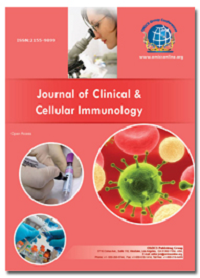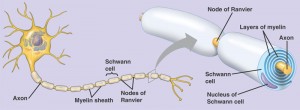 A study published in the current issue of the Journal of Clinical & Cellular Immunology found indicators of autoimmunity to critical brain proteins associated with mercury exposure in children with autism. The authors, Gehan Ahmed Mostafa and Laila Yousef AL-Ayadhi at the Department of Pediatrics, Faculty of Medicine, Ain Shams University, in Cairo, Egypt and the Autism Research and Treatment Center in the Department of Physiology, Faculty of Medicine, at King Saud University in Riyadh, Saudi Arabia, respectively, hypothesize that mercury might play a causative role in some cases of autism through increased levels of antibodies to myelin basic protein, or MBP.
A study published in the current issue of the Journal of Clinical & Cellular Immunology found indicators of autoimmunity to critical brain proteins associated with mercury exposure in children with autism. The authors, Gehan Ahmed Mostafa and Laila Yousef AL-Ayadhi at the Department of Pediatrics, Faculty of Medicine, Ain Shams University, in Cairo, Egypt and the Autism Research and Treatment Center in the Department of Physiology, Faculty of Medicine, at King Saud University in Riyadh, Saudi Arabia, respectively, hypothesize that mercury might play a causative role in some cases of autism through increased levels of antibodies to myelin basic protein, or MBP.
MBP is necessary for proper nerve signaling. It is the building block for the myelin sheath that covers the axons of nerve cells. Mercury is a global public health concern. Drs. Mostafa and Al-Ayadhi note that exposure can occur through air pollution, by eating certain types of fish, and from lotions, creams, and medical products like dental fillings, and eye drops.
Their study compared blood mercury levels between 100 children with autism age 5-12 and 100 healthy age and sex-matched controls attending clinics in Cairo, Egypt. They found the autism group to have significantly higher blood mercury levels than the controls (P<0.001). Within the autism group, 72% had positive results of serum anti-MBP auto-antibodies, significantly higher than healthy controls (5%, P<0.001). The higher the child’s mercury level, the more likely the child tested positive for anti-MPB antibodies. The relationship was also statistically significant (P<0.001).
The authors cite previous studies which might explain the association between autism, mercury, and brain autoantibodies. This work includes increased autoimmunity in autism and decreased capacity to detoxify heavy metals, as well as the immunotoxic properties of mercury itself. These connections support the growing body of autism research on the role of environmental exposures, a dysregulated immune system, altered synaptic connectivity, impaired detoxification, and mitochondrial disorders.
Other studies have found increased frequency of autoantibodies common to mercury exposure (ANA and ALA) in mothers of children with autism. The connection between some cases of autism and autoantibodies to MBP was detected over a decade ago, possibly arising from an inappropriate immune response to measles virus or vaccine antigen (see, for example, the work of Vihendra Singh), but the new paper by Mostafa and AL-Ayadhi is the first time that MBP antibodies have been linked to mercury in autistic children.
The authors suggest that investigations be conducted on the benefits of chelation therapy to remove mercury from children with autism who have higher mercury levels. SafeMinds notes that chelation therapy for autism is experimental.
 SafeMinds funded several of the studies cited in this article, including work from Jill James (detoxification, mitochondria) and
SafeMinds funded several of the studies cited in this article, including work from Jill James (detoxification, mitochondria) and
William Parker (immune regulation). SafeMinds worked for many years with the United Nations Environmental Programme to try and draft an international treaty to end unnecessary use of mercury in all health products around the world, so that no child receives harmful exposures like these children in Egypt used for the Mostofa & AL-Ayadhi study. SafeMinds co-founder Lyn Redwood started the autism-mercury discussion group 15 years ago to help individuals help each other alleviate harm from mercury exposure. You can help us continue our work by donating to one of our funds, or by contacting us to volunteer.
Links/Sources
Mostafa GA, AL-Ayadhi LY. The Possible Association between Elevated Levels of Blood Mercury and the Increased Frequency of Serum Anti-myelin Basic Protein Auto-antibodies in Autistic Children. J Clin Cell Immunol 6:310. doi: 10.4172/2155-9899.1000310
WHO Bulletin. Preventing Disease Through Healthy Environments. Exposure To Mercury: A Major Public Health Concern. 2007. http://www.who.int/phe/news/Mercury-flyer.pdf
Maezawa I, Calafiore M, Wulff H, Jin LW. Does microglial dysfunction play a role in autism and Rett syndrome? Neuron Glia Biol. 2011 Feb;7(1):85-97. doi: 10.1017/S1740925X1200004X. Epub 2012 Apr 30.
Frye RE, Delatorre R, Taylor H, Slattery J, Melnyk S, Chowdhury N, James SJ. Redox metabolism abnormalities in autistic children associated with mitochondrial disease. Transl Psychiatry. 2013 Jun 18;3:e273. doi: 10.1038/tp.2013.51.
Singh VK, Lin SX, Newell E, Nelson C. J. Abnormal measles-mumps-rubella antibodies and CNS autoimmunity in children with autism. Biomed Sci. 2002 Jul-Aug;9(4):359-64. http://www.ncbi.nlm.nih.gov/pubmed/12145534/
Cinthia Pi, Emma H. Allott, Daniel Ren, Susan Poulton, Y. Ryan Lee, Sarah Perkins, Mary Lou Everett, Zoie E. Holzknecht, Shu S. Lin, and William Parker. Increased Biodiversity in the Environment Improves the Humoral Response of Rats. PLoS One. 2015; 10(4): e0120255. Published online 2015 Apr 8. doi: 10.1371/journal.pone.0120255. http://www.ncbi.nlm.nih.gov/
Bilbo SD, Nevison CD, Parker W. A model for the induction of autism in the ecosystem of the human body: the anatomy of a modern pandemic? Microb Ecol Health Dis 2015;26:26253 doi: 10.3402/mehd.v26.26253. http://www.ncbi.nlm.nih.gov/
Rose S, Wynne R, Frye RE, Melnyk S, James SJ. Increased susceptibility to ethylmercury-induced mitochondrial dysfunction in a subset of autism lymphoblastoid cell lines. J Toxicol. 2015;2015:573701. doi: 10.1155/2015/573701. Epub 2015 Jan 21.
Frye RE, Delatorre R, Taylor H, Slattery J, Melnyk S, Chowdhury N, James SJ. Redox metabolism abnormalities in autistic children associated with mitochondrial disease. Transl Psychiatry. 2013 Jun 18;3:e273. doi: 10.1038/tp.2013.51.



